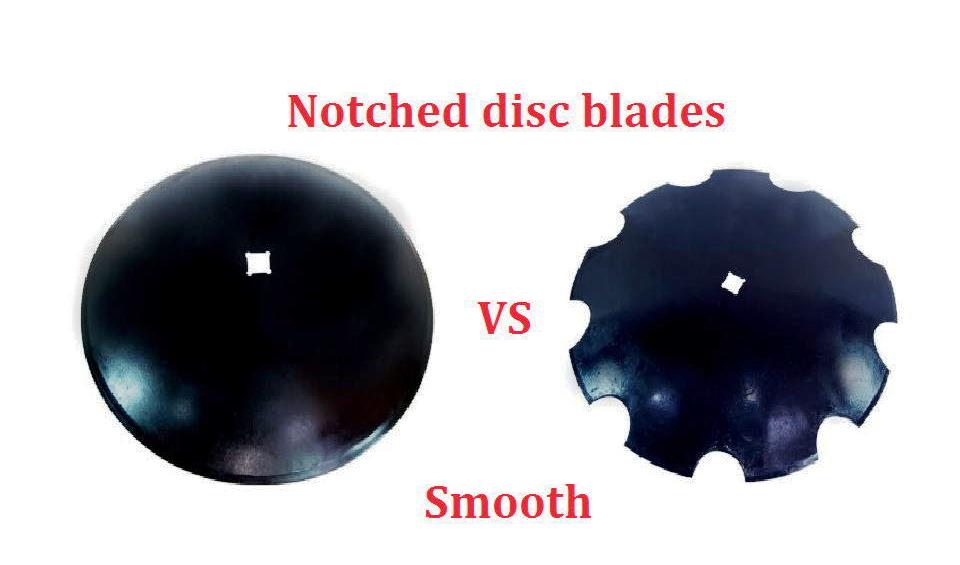As an Amazon affiliate, we earn a commision from qualifying purchases.
This article compares notched disc blades vs smooth discs comprehensively to help you point you in the right direction:
A disc harrow opens (and breaks) up the soil to help prep the soil for planting/sowing.
And often the available configurations (when it comes to the cutting blades) are:
- Smooth edge discs (or plain edge discs)- like the title suggests, these consist of plain (all smooth) discs that are typically best for normal soil conditions.
- Notched edge discs (cut-away discs/scalloped edge discs)- the standout difference in these disc blades is the serrated edges which makes them cut remainder crops and weeds quickly in harder soils.
I have just given you some cues in the above description but there’s more you need to know about each disc blade type.
This article compares notched disc blades vs smooth comprehensively to help point you in the right direction:
The fact is: The hybrid configuration with notched discs in front and smooth at the back, is quite a popular option and a worthy choice to ponder.
Still, you may choose aggressive notched discs both in front and the rear (or even ‘all smooth’…you get me?).
Don’t fret if unsure that this is the way to go- here is all you need to understand..
Notched disc blades vs Smooth- what disc blade should you go for?
Here we go:
Notched disc blades vs Smooth –Performances
Whether you’re breaking new ground, or tilling your existing nursery, vineyard, food plot, or farm, it’s important to have the best performing disc blade for the task at hand.
And it all boils down to the current soil conditions..
Keep this in mind:
In tougher conditions, go for notched discs
Notched discs typically cut deeper in tough conditions- think of large food plots with insanely hard soils, lots of rocks, branches, limbs, and other kinds of debris.
Likewise, notched discs cut and chop grass and crop stubble nicely.
In contrast, smooth discs sometimes skid over roots and other obstructions that notched discs beautifully penetrate and will leave you disappointed in rocky land and other difficult soil environments.
Bottom-line? Go for notched discs in all situations where flawless trash cutting and deeper penetration is desired.
For land that is free of very thick trash and other stubborn debris, pick smooth discs
Where you just want nice, even cutting, smooth discs work well except for land that has never been plowed and tilled.
In fact, solid (smooth) blades cut trash with no skips unless the residue is super thick or the soil is packed with rocks, stalks, tree roots, branches, etc.
And so we recommend that you select smooth blades if you’re working on soil that has previously been broken up.
In truth, smooth disks suit a bigger number of environments than you may first think in home landscaping projects, small hobby farms, small nurseries, wild game food plots, and more.
Take a look:
- Soil types/conditions that are easier to slice through- These include sandy, loose, and most dry soils. Of course, by their very nature, these types of soils are pretty easy to cut through.
- Where a smooth finish is needed- These disc blades are more useful when the ground just requires evening out, as long as the crop residue is light to medium. As such, they’re the best to use as secondary tillage (of course, in conjunction with cut-away discs) for the most part.
Put simply, plain discs will work without trouble under regular soil conditions.
You know the ones I mean? Terrain that doesn’t hindrances such as rocks and sticks (or simply non- high-residue situations)!
Notched disc blades vs Smooth – pros and cons
Notched disc blades- upsides
· Better results in the toughest soils
As mentioned, notched disks outshine smooth when plowing more clay/rocky grounds.
The same is true on harder soils.
The reason? Their maximum cutting action helps them crush such soils.
In short, the more overgrown your vegetation, the happier you’ll be with notched blades.
Notched disc blades- downsides
· Need frequent replacement
Notched blades tend to wear down faster than smooth for the simple reason that notched discs dull out faster-and you cannot sharpen them easily.
Smooth blades- pros
· More affordable
In terms of pricing, smooth disk blades tend to be cheaper to buy.
· Cheaper to maintain
First, these blades are less vulnerable to chipping (they’ve more surface area) compared to notched disk blades (and wear better than notched blades).
Secondly, they’re easier to sharpen -and they don’t even need to be sharpened a lot (just once in a year could be enough).
Smooth blades- cons
· Not great for challenging conditions
They are less effective in heavily compacted soils (and clay) with or without dense residue.
Notched disc blades vs Smooth- verdict
In general, opt for serrated edge disc blades if you’re faced with clay-like ground conditions.
On the other hand, the smooth/plain discs are the better option if your land resembles sand.
This helps you properly prepare the soil for a bumper crop yield!
Final words
Many cases can be put forward for all-smooth blades, and a similarly high number of cases for all-notched blades, but for general, all-around use, you might want to go for the mixed setup- the notched blades in front usually cuts stalks and harder soil better while the smooth rear blades leave a finer finish.
Keep in mind that when buying new disc blades, you’ll typically find numerous gauges (thickness) on offer at different price points.
If you’re going the notched blades way (because of the clay-like ground conditions) buy the thickest gauge you can find as the extra weight can make a massive difference when cutting through crop residues, meatier roots, and other obstacles.
ALSO READ:
What is the best tool to cut sod?

